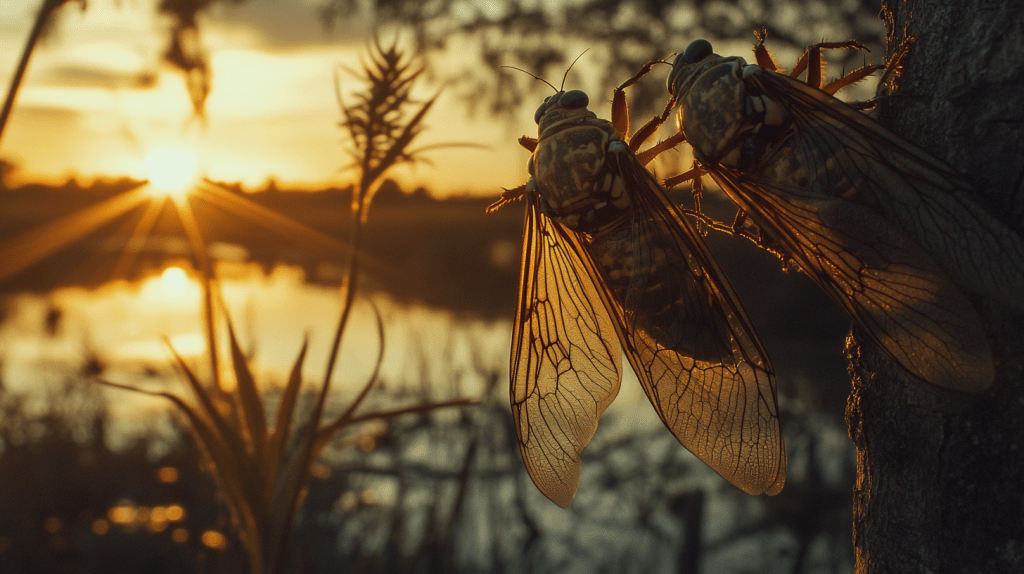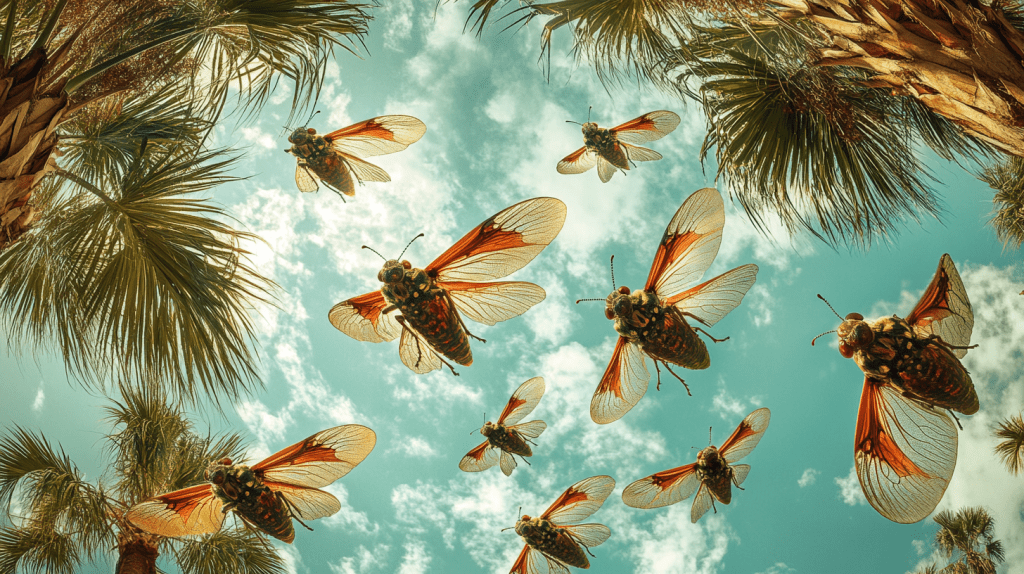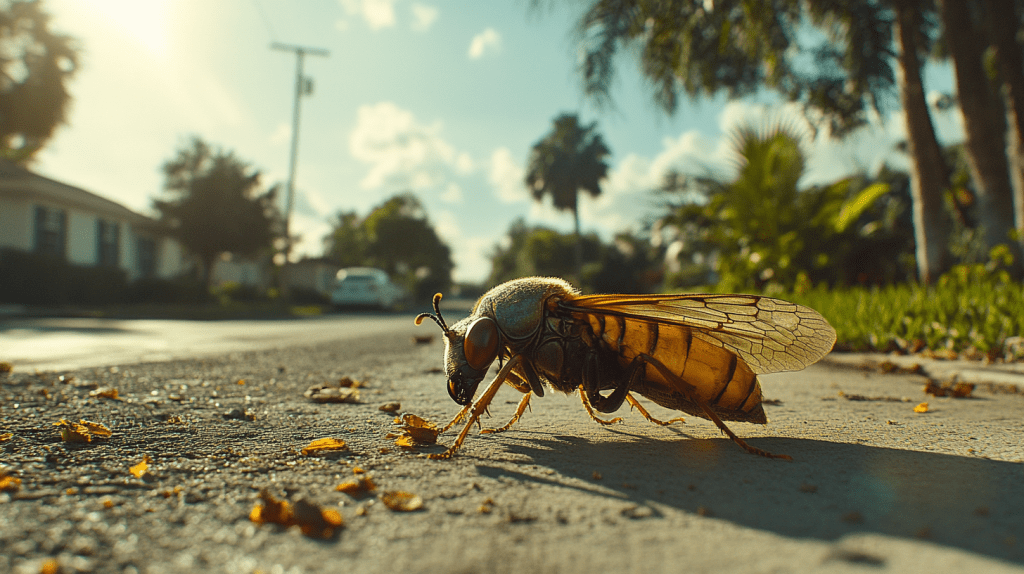Table of Contents
If you’re looking to get rid of cicada killers around your Venice, FL property, you’re not alone. These large, solitary wasps might look intimidating, but they’re generally non-aggressive and fascinating to learn about. Standing out with their black-and-yellow-striped bodies and reaching up to two inches in length, cicada killers are among the largest wasps in North America. Their life’s mission revolves around hunting cicadas, which they paralyze and bury as a food source for their larvae. Each female cicada killer digs intricate burrows, creating individual chambers where she places a cicada and lays a single egg, allowing her offspring to feed and develop independently.
However, their choice of nesting sites often leads them to sunny, sandy areas like gardens, yards, and even playgrounds, where their mounds of soil can become a bit of a nuisance. Despite their solitary nature, the appearance of multiple burrows in one area can make it feel like an invasion. In this guide, we’ll explore practical, non-harmful methods to get rid of cicada killers, helping you reclaim your outdoor space in Venice without disrupting these fascinating creatures more than necessary. Let’s dive into strategies that offer a balance between control and conservation.
Key Takeaways
- Identify and Understand: Cicada killers are large, solitary wasps with black and yellow bodies. Females hunt cicadas to feed their larvae, while males are harmless and lack stingers.
- Non-Aggressive Nature: Though intimidating in appearance, cicada killers are generally non-aggressive and rarely sting humans, focusing instead on hunting cicadas.
- Natural and Chemical Solutions: For natural control, keeping soil moist and covering bare patches with mulch can discourage burrowing. For targeted removal, methods like boiling water or boric acid in burrows are effective options.
- Preventive Measures: Minimize open, dry soil patches, keep soil moist, and repair loose screens or wall cracks to reduce nesting areas. Encouraging natural predators like birds also aids in controlling cicada killer populations.
- Seek Professional Help if Needed: For large infestations or persistent burrows, professional pest control offers effective and safe options, including ongoing services for larger properties.
By taking these steps, you can effectively manage cicada killers around your property while respecting their role in nature, allowing you to enjoy your outdoor spaces with fewer interruptions from these large, solitary wasps.
What Are Cicada Killers?
Cicada killers are large, solitary wasps that prey on cicadas, provisioning their nests with paralyzed cicadas for larvae. Though intimidating, they are not aggressive towards humans. These wasps prefer sandy or loose soil for burrows and emerge in summer. While they help control cicada populations, their burrows may disturb lawns or gardens.
Understanding Cicada Killers – Nature’s Unique Wasp Hunters

Cicada killers, one of the largest wasp species in North America, often cause a stir when they appear around gardens, golf courses, and sandy lawns in Venice, FL. Reaching up to 2 inches in length, these wasps have dark brown to black bodies with striking yellow markings, amber-colored wings, and rust-colored eyes, legs, and antennae. While their size and distinctive appearance can be intimidating, cicada killers are solitary wasps, meaning they don’t form colonies. Instead, each female digs her own burrow, creating a U-shaped mound of soil at the entrance—a clear sign of their nesting activity.
Active from mid to late summer, usually peaking around July and August, cicada killers are known for their unique and somewhat dramatic behavior. Males, though harmless as they lack a stinger, are highly territorial, patrolling nesting areas and chasing away other males to establish dominance. Females, on the other hand, have a single focus: hunting cicadas. Each female paralyzes her prey with a sting, then drags the cicada back to her burrow to feed her larvae. Once she’s secured the food, she lays an egg on the paralyzed cicada, sealing it inside a chamber within her burrow. This process ensures her larvae will have a fresh meal as they develop.

Effective Cicada Killer Control with Venice Exterminators!
Struggling with cicada killers taking over your yard? Contact Venice Exterminators at (941) 299-8937 for professional cicada killer control services! Serving the entire Venice, FL area, we’re here to help protect your property from these intimidating wasps, ensuring a safe and pest-free environment.
Get Cicada Killer Control Today!Cicada killers prefer open, sunny areas with sandy or well-drained soil, which is why their burrows are often found in lawns, gardens, or fields. Despite their size and visible stingers, female cicada killers rarely sting humans unless provoked, and their focus remains on cicadas rather than people. Their lifecycle includes just one generation per year, with adult wasps emerging from their underground burrows in late June or July. After mating and establishing burrows, the larvae overwinter in these chambers, protected from the elements, and emerge as adults the following summer.
For those concerned about these large, formidable-looking wasps, it’s reassuring to know that they play an essential role in controlling cicada populations, preventing outbreaks that could impact trees and other vegetation. While they may look intimidating, cicada killers are generally harmless to humans and focus solely on hunting cicadas and providing for their young.
Get Rid of Cicada Killers – Safe Removal Tips for Venice Residents

Cicada killers, one of the largest wasp species in North America, often cause a stir when they appear around gardens, golf courses, and sandy lawns in Venice, FL. Reaching up to 2 inches in length, these wasps have dark brown to black bodies with striking yellow markings, amber-colored wings, and rust-colored eyes, legs, and antennae. While their size and distinctive appearance can be intimidating, cicada killers are solitary wasps, meaning they don’t form colonies. Instead, each female digs her own burrow, creating a U-shaped mound of soil at the entrance—a clear sign of their nesting activity.
Active from mid to late summer, usually peaking around July and August, cicada killers are known for their unique and somewhat dramatic behavior. Males, though harmless as they lack a stinger, are highly territorial, patrolling nesting areas and chasing away other males to establish dominance. Females, on the other hand, have a single focus: hunting cicadas. Each female paralyzes her prey with a sting, then drags the cicada back to her burrow to feed her larvae. Once she’s secured the food, she lays an egg on the paralyzed cicada, sealing it inside a chamber within her burrow. This process ensures her larvae will have a fresh meal as they develop.
Key Points for Identifying Cicada Killers

1. Appearance
Cicada killers are large wasps, ranging from 1.5 to 2 inches (3.8 to 5 cm) in length. They have black or dark brown bodies with yellow markings on their abdomens, amber-colored wings, and rust-colored eyes, legs, and antennae. Females are generally larger than males.
2. Distinctive Features
As one of the largest wasp species in North America, cicada killers are solitary wasps and do not live in colonies. Females have a large, visible stinger but rarely use it on humans, while males lack a stinger.
3. Behavior
These wasps are most active in mid to late summer, around July and August. Females dig burrows in sandy or loose soil, while males patrol nesting areas. Females hunt and paralyze cicadas to provision their nests.
4. Habitat
Cicada killers prefer areas with well-drained, light-textured soil in full sunlight. They are commonly found near lawns, golf courses, and open spaces, with nesting burrows marked by a U-shaped mound of kicked-out soil at the entrance.
5. Life Cycle
There is one generation per year, with adults emerging in late June or July. Larvae overwinter in underground burrows until they emerge the following summer.
6. Distribution
The eastern cicada killer (*Sphecius speciosus*) is common in the eastern United States, while other species are found in the western U.S. and throughout North America.
While cicada killers may appear intimidating due to their size, they are generally non-aggressive towards humans and will only sting if severely provoked.
Cicada killers prefer open, sunny areas with sandy or well-drained soil, which is why their burrows are often found in lawns, gardens, or fields. Despite their size and visible stingers, female cicada killers rarely sting humans unless provoked, and their focus remains on cicadas rather than people. Their lifecycle includes just one generation per year, with adult wasps emerging from their underground burrows in late June or July. After mating and establishing burrows, the larvae overwinter in these chambers, protected from the elements, and emerge as adults the following summer.
For those concerned about these large, formidable-looking wasps, it’s reassuring to know that they play an essential role in controlling cicada populations, preventing outbreaks that could impact trees and other vegetation. While they may look intimidating, cicada killers are generally harmless to humans and focus solely on hunting cicadas and providing for their young.
How to Get Rid of Cicada Killers in Your Yard

If cicada killers have taken up residence in your yard, there are several effective ways to manage and discourage them from nesting in the area. These large, solitary wasps tend to prefer dry, sandy soil in sunny areas, so keeping the soil moist through regular watering can help make your yard less attractive to them. For targeted removal, the boiling water method is commonly used: simply locate the burrow, mark it, and pour boiling water into the entrance at night when the wasps are inactive, covering it until the next day. For more thorough results, chemical treatments like ammonia or boric acid can be applied, with boric acid being especially effective as it targets both adult wasps and eggs.
Effective Methods to Get Rid of Cicada Killers
1. Keep Soil Moist
– Cicada killers prefer dry soil in full sunlight for nesting. Maintaining moist soil through regular watering can make the area less attractive to them.
2. Boiling Water Method
– Locate the burrow entrance and mark it. At night, pour boiling water into the hole and cover the entrance with a glass bowl until the next day.
3. Chemical Treatments
– Ammonia: Pour into the hole and cover it. This kills the wasps but may not affect the eggs.
– Boric Acid: A more thorough method, killing both the wasps and their eggs.
4. Professional Pest Control
– Experts can assess the situation and apply targeted treatments. Cost ranges from $250 to $550 for one-time treatment, with quarterly or monthly options for ongoing control.
5. Preventive Measures
– Repair loose or damaged window screens, seal cracks in exterior walls, and minimize bare soil patches in lawns or garden beds. Cover exposed areas with mulch or ground cover plants.
6. Natural Predators
– Encourage natural predators of cicada killers in your yard to help keep their population under control.
Important Notes
- Cicada killers are generally not aggressive and rarely sting humans unless provoked.
- They can be beneficial as pollinators and for controlling cicada populations.
- If using chemical methods, always follow safety precautions and consider potential environmental impacts.
- For severe infestations or safety concerns, consider consulting professional pest control services.
If dealing with multiple nests or looking for a long-term solution, professional pest control services can provide targeted treatments and ongoing maintenance, with options ranging from one-time applications to quarterly visits. Preventive measures are also key—sealing cracks in walls, maintaining window screens, and covering bare soil patches with mulch or ground cover can help deter cicada killers from returning. It’s worth noting that these wasps are generally not aggressive and rarely sting humans, as their primary focus is on hunting cicadas to feed their young. Encouraging natural predators of cicada killers in your yard is another environmentally friendly option. For those who may have larger infestations or safety concerns, professional pest control remains a safe and reliable solution.
In conclusion, managing cicada killers around your property in Venice, FL, can be achieved with a combination of targeted control methods and preventive measures. By understanding their preferences for dry, sandy soil in sunny areas, you can make simple adjustments, like keeping soil moist and covering bare patches, to make your yard less appealing for nesting. When dealing with established burrows, methods such as boiling water, boric acid, or professional pest control offer effective solutions. However, it’s also important to remember that cicada killers are solitary, non-aggressive wasps that rarely pose a threat to humans and play a valuable role in controlling cicada populations.
By taking these steps, you can enjoy a more comfortable outdoor space while preserving the natural balance in your garden. If infestations persist, consulting with a pest control professional will ensure a safe, long-term approach to keeping these large but generally harmless wasps in check.
Frequently Asked Questions (FAQs)
What attracts cicada killers to my yard?
Cicada killers are drawn to open, sunny areas with dry, sandy, or well-drained soil. These environments make it easier for them to dig their burrows, which can often be seen in yards, gardens, golf courses, and other sunny spaces with minimal ground cover. They are also attracted to areas with a high cicada population, as they rely on cicadas to feed their larvae.
Are cicada killers aggressive?
No, cicada killers are generally not aggressive towards humans. While their large size and visible stinger on females can be intimidating, they rarely sting unless handled or provoked. Male cicada killers don’t have stingers but may appear aggressive when defending their territory, though they pose no actual threat.
How can I identify a cicada killer wasp?
Cicada killers are large wasps, typically ranging from 1.5 to 2 inches long. They have dark brown or black bodies with yellow markings on their abdomens, amber-colored wings, and rust-colored eyes, legs, and antennae. Females are usually larger than males and have a visible stinger.
What is the lifecycle of a cicada killer?
Cicada killers have one generation per year. Adults emerge in mid to late summer, typically around June or July, to mate and build burrows. After hunting and paralyzing cicadas, the female places them in the burrow chambers as food for her larvae. The larvae will overwinter in the burrows, emerging as adults the following summer.
How do I get rid of cicada killer wasps naturally?
Keeping the soil moist is one of the simplest natural methods, as cicada killers prefer dry soil for burrowing. Regular watering in areas where they tend to nest can discourage them from establishing burrows. Additionally, covering bare soil patches with mulch, grass, or ground cover plants can make the area less inviting.
What is the boiling water method for cicada killers?
The boiling water method involves locating and marking the burrow entrance, then pouring boiling water into the hole at night when the wasps are less active. Cover the entrance with a glass bowl or other barrier until the next day to prevent the wasps from escaping. This method can be effective, though it requires caution when handling boiling water.
Are chemical treatments effective for getting rid of cicada killers?
Yes, chemical treatments like ammonia and boric acid can be effective. Pouring ammonia into the burrow and covering it helps kill the adult wasps, although it does not affect the eggs. Boric acid is more thorough, as it can target both adult wasps and eggs. Always follow safety precautions when using chemicals and consider the environmental impact, especially around beneficial insects and plants.
When should I consider hiring professional pest control for cicada killers?
If you’re dealing with multiple burrows or have safety concerns, professional pest control can provide targeted and effective treatment options. Professionals can assess the extent of the infestation and use specialized methods to safely remove cicada killers. Costs typically range from $250 to $550 for a one-time treatment, with ongoing services available for larger infestations.
Can cicada killers damage my lawn or garden?
While cicada killers dig large burrows, which can result in small mounds of soil at the entrance, they don’t generally cause significant damage to lawns or plants. However, if you have multiple burrows, the mounds can become an aesthetic concern. Regular maintenance and preventive measures, like covering exposed soil, can help reduce their impact.
What are some preventive measures to keep cicada killers away?
Preventive measures include keeping soil moist, covering bare patches with mulch or ground cover, and sealing any cracks in exterior walls that could serve as potential nesting sites. Repairing loose or damaged window screens and minimizing access points can also help keep cicada killers from nesting close to your home.
Do cicada killers have any natural predators?
Yes, birds, spiders, and other larger wasps are natural predators of cicada killers. By encouraging a healthy ecosystem with a variety of wildlife in your yard, you can naturally help manage cicada killer populations without direct intervention.
How can I tell the difference between male and female cicada killers?
Female cicada killers are larger than males and have a visible stinger, although they rarely use it on humans. Males, on the other hand, lack a stinger entirely but may appear aggressive as they patrol their territory and chase away other males.
Are cicada killers beneficial to the environment?
Yes, cicada killers play an important role in controlling cicada populations, which can help protect trees and other vegetation. Although their presence may be unsettling, they serve a valuable ecological purpose and are generally harmless to humans.
How do cicada killers hunt and provision their nests?
Female cicada killers hunt cicadas, paralyzing them with a sting before carrying them back to the burrow. Each burrow chamber is provisioned with one cicada, where the female then lays an egg. The larva hatches and feeds on the cicada, developing in the burrow until the next season.
What is the best time of day to treat cicada killer burrows?
Nighttime is generally the best time to treat cicada killer burrows, as the wasps are less active and most are likely to be inside the burrow. This reduces the chance of being confronted by the wasps and increases the effectiveness of boiling water or chemical treatments.











